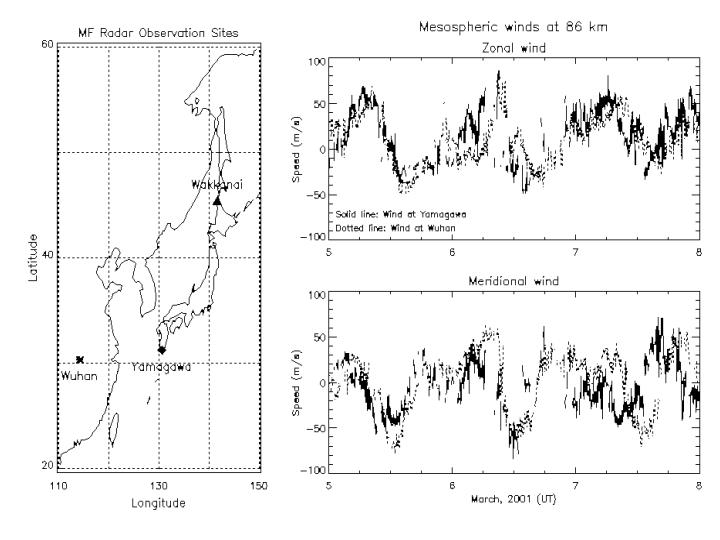Rìi31.2N,130.6EjÆ¿(30.7N, 114.5E)ÌMF[_ÉæéÔ ÌÅÌärÊ
Rìi31.2N,130.6EjÆ¿(30.7N, 114.5E)ÌMF[_ÉæéÔ ÌÅÌärÊ
*Ü\ ìÇ[1], Guanyi Ma[1], Zhang Xunjie[2]
Hu Xiong[2]
Wuhan Institute of Physics and Mathematics[2]
First comparison results of mesospheric winds between Yamagawa(31.2 N, 130.6E) and Wuhan (30.7N, 114.5E) using MF radar
*Kiyoshi Igarashi[1]
,Guanyi Ma [1],Zhang Xunjie [2]
Hu Xiong [2]
Communications Research Laboratory[1]
Wuhan Institute of Physics and Mathematics[2]
A new MF radar system in Wuhan (30.7 N, 114.5 E) was setup in December 22, 2000 by Wuhan Institute of Physics and Mathematics, Chinese Academy of Sciences (Zhang Xunjie, and Hu Xiong). It is located in the north-east corner of Wuhan, China. The radar operates at frequency of 2.01 MHz and peak transmitter power of 25kW. The transmitter antennas consist of four half-wave dipoles which forme a square. The receiver antennas consiste of three pairs of crossed dipoles, which are in the vertexes of an equilateral triangle. Yamagawa MF radar is located in the same latitude and longitude difference is just 15 degree. We have made a comparison of mesospheric winds between Yamagawa and Wuhan during PREASA-VI campaign from February to March, 2001. In the comparison of March 5 to 7, 2001 strong diurnal tides and similar amplitude of winds are confirmed for both sites. A few hourfs phase progress at Yamagawa is appeared at 86 km in zonal wind. We found that a big difference appeared in the meridional wind on March 7, 2001. This seems to be a caused by local disturbances. Continuous observations at the sites (Wakkanai, Yamagawa and Wuhan) provide daily estimates of mean wind and tidal parameters. This MF radar network would be largely usefull in the interpretation of mean circulation and tidal variavilities.
